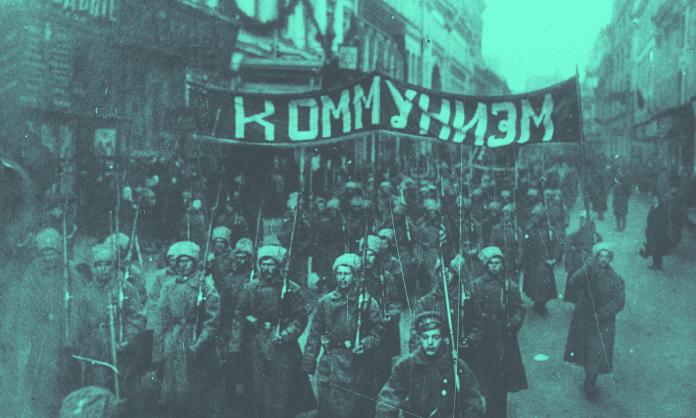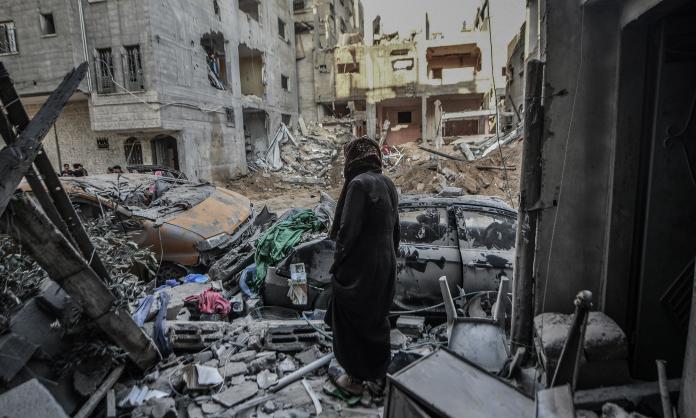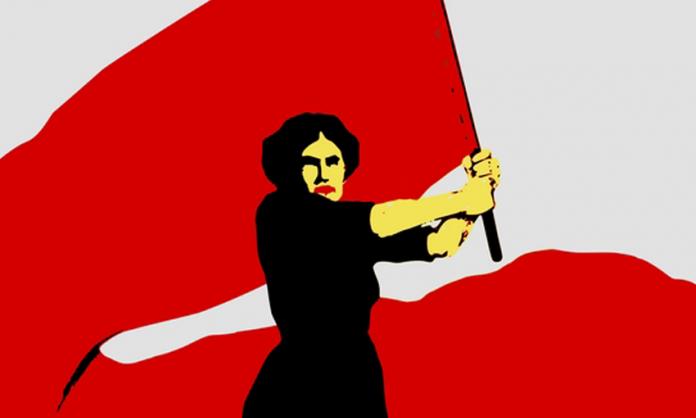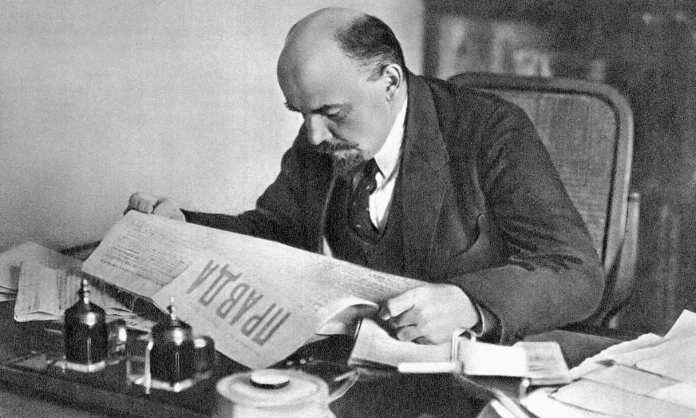“If they do me in, I ask you to publish my notebook: Marxism on the State (it got left behind in Stockholm). It’s bound in a blue cover ... There are a number of remarks and notes ... I believe it to be important”.
So wrote Lenin with characteristic modesty in July 1917. He was referring to what later became known as The State and Revolution, one of the most important contributions to Marxist thought of the last century.
The short pamphlet was written in response to the turmoil that engulfed the socialist movement following the outbreak of World War One. Many socialist organisations that had previously professed to be revolutionary, and aligned themselves to the ostensibly Marxist Second International grouping, succumbed to the nationalist hysteria sweeping Europe at the time.
The slow drift towards accommodation to capitalism resulted in 1914 in open support for their national governments and bourgeoisies. Where they held seats in Parliament, such as in Germany, socialist MPs voted to support the bloodshed and mass murder of workers. This abandonment of principles on the part of professed socialists horrified Lenin, along with other genuine Marxists.
The State and Revolution represented his attempt to reassert the Marxist attitude to the state in order to show why the capitalist state needed to be destroyed—not tamed—and replaced with workers’ power. Such a restatement was important not simply to discredit the so-called socialists of the Second International, but also as a guide to action for the millions of workers across Europe whose struggles against war and the accompanying deprivation were beginning to rock the foundations of European capitalism.
As Lenin wrote in the preface to the first edition: “The unprecedented horrors and miseries of the protracted war are making the people’s position unbearable and increasing their anger. The world proletarian revolution is clearly maturing. The question of its relation to the state is acquiring practical importance.”
The starting point for his argument was the class nature of the capitalist state. Drawing on the writings of Marx and Engels, Lenin demolishes the idea that the state is a neutral body standing above social classes. Instead, he argues that the state exists as a means for one class to maintain its dominance over another. Far from being able to legislate away the conflict between workers and bosses under capitalism, “the state is a product and manifestation of the irreconcilability of class antagonisms. The state arises where, when and insofar as class antagonisms objectively cannot be reconciled. And, conversely, the existence of the state proves that the class antagonisms are irreconcilable ... The state is an organ of class rule, an organ for the oppression by one class by another; it is the creation of ‘order’, which legalizes and perpetuates this oppression by moderating the conflict between the classes.” The arbitration system, courts and prisons, insofar as they legitimise wage labour and enshrine the property rights of the rich, are all examples of this today.
Coercion is also central to the power of the capitalist state. As Lenin puts it: “What does this power [of the state] mainly consist of? It consists of special bodies of armed men having prisons, etc. at their command ... A standing army and police are the chief instruments of the state power.”
Given the capitalist state exists to enforce the interests and property rights of the capitalist class, it cannot be taken over by representatives of the working class and used to introduce socialism as the reformists of the Second International ultimately argued. It must instead be destroyed and dismantled in order that the power of the capitalist class be neutralised, and the capitalists prevented from reasserting their dominance following a successful workers’ revolution.
For this to happen, workers must become the dominant class in society. As Lenin described: “The overthrow of the bourgeoisie can be achieved only by the proletariat becoming the ruling class, capable of crushing the inevitable and desperate resistance of the bourgeoisie, and of organising all the working and exploited people for the new economic system.
“The proletariat needs state power, a centralized organisation of force, an organisation of violence, both to crush the resistance of the exploiters and to lead the enormous mass of the population—the peasants, the petty bourgeoisie, the semi-proletarians—in the work of organising a socialist economy.” So it is not enough to simply abolish the capitalist state, it must be replaced with organisations that embody and defend workers' control of society.
But such a state would have little in common with all previously existing states which have enshrined minority rule. The Paris Commune of 1871 provided the first example of what workers’ power might ultimately look like. A keen observer of the Commune, Marx described how: “The first decree of the Commune ... was the suppression of the standing army and its replacement by the armed people ... The Commune was formed of the municipal councillors, chosen by universal suffrage in the various wards of Paris, responsible and revocable at any time. The majority of its members were naturally working men, or acknowledged representatives of the working class ... The police, which until then had been the instrument of the government, was at once stripped of its political attributes and turned into the responsible and at all times revocable instrument of the Commune ... From the members of the Commune downwards, public service had to be done at workmen’s wages. The privileges and the representation allowances of the high dignitaries of state disappeared along with the dignitaries themselves.”
The significance of the Commune and its contrast with the capitalist state for Lenin could not be overstated: “The Commune [has] replaced the smashed state machine ‘only’ by fuller democracy: abolition of the standing army; all officials to be elected and subject to recall. But as a matter of fact, this ‘only’ signifies a gigantic replacement of certain institutions by other institutions of a fundamentally different type.”
Lenin also argued that a workers’ state differs from previous forms in its transitory nature. Societies in which the ruling class relies on the day-to-day exploitation and oppression of the majority require a permanent state structure to ensure social stability and compliance.
Once in control, the working class does not have to oppress any other social class in order to run society effectively and provide for people’s needs. Without class divisions, there is no need for a state. In the long run therefore, a genuine socialist society would be one without the need for an oppressive state structure.
The main function of a workers’ state then is to ensure the defeat of the capitalist class, and to prevent it being able to regroup or rearm to destroy the revolution and workers’ power.
As Lenin explained: “The organ of suppression, however, is here the majority of the population, and not a minority, as was always the case under slavery, serfdom and wage slavery. And since the majority of people itself suppresses its oppressors, a ‘special force’ of suppression is no longer necessary! In this sense, the state begins to wither away.”
For the organisations of the Second International, that had integrated themselves into the capitalist state and ruling structures in a way that did not incline them towards its smashing, Lenin’s arguments were somewhat unwelcome. The State and Revolution was decried as Blanquist and anarchist amongst the mainstream of the socialist movement.
By contrast, among left-wing critics of the orthodox socialist movement of the time, including some anarchists, The State and Revolution was a revelation. Syndicalist Alfred Rosmer recalled its reception in France: “for revolutionaries situated outside the mainstream of orthodox Marxism, for the syndicalists and anarchists, this ... was a pleasant revelation. They had never heard such language from the Marxists they knew. They read and re-read this interpretation of Marx, which was quite unfamiliar to them.”
The all-too-common characterisation of Lenin as an authoritarian by anarchists today is thus both ironic and woefully inaccurate. Again and again throughout his political life, including in The State and Revolution, Lenin stressed the conscious activity of workers as crucial to the struggle to create a new and better world. In 1906, he wrote of his eagerness to see the working class “smash all the instruments for oppressing the people, seize power, and take what was regarded as belonging to all kinds of robbers of the people—in short, when the intellect and reason of millions of downtrodden people awaken not only to read books, but for action, vital human action, to make history.”
The revolution Lenin lived through and led shortly after completing The State and Revolution is a testament to this. John Reed, and American journalist who was in Russia during the revolution described how “for the first time, millions of ordinary workers and peasants found themselves able to participate in the major decisions that affected their lives. Control of the factories was taken over by the workers, land was seized by the poor peasants, the embryo of an entirely new form of society was created.”
The official structures of workers power reflected this: “At least twice a year delegates are elected from all over Russia to the All-Russian Congress of Soviets...This body, consisting of about two thousand delegates, meets in the capital in the form of a great soviet, and settles upon the essentials of national policy.” According to Reed, “no political body more sensitive and responsive to the popular will was ever invented.”
The contrast between the participatory democracy of the most advanced form of workers’ power ever seen and the oppressive nature of the capitalist state could not be greater. It makes a mockery of those who reject state power as authoritarian regardless of which class is in control.
More than one hundred years after it was written, The State and Revolution remains the clearest exposition of the role of the state and the need for the masses to destroy it in order to bring about a society without class divisions of any sort.











